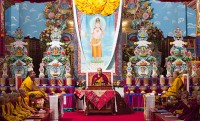法王新闻 | 2015年01月
比丘尼讚 ——〈比丘尼教法興盛儀軌〉修法
In Praise of Bhikshunis: A Ritual for the Nuns’ Dharma to Flourish

時間:2015年1月20日 20 Jan., 2015
地點:印度 菩提迦耶 德噶寺, Tergar Monastery, Bodhgaya, India
During the Second Arya Kshema Winter Dharma Gathering, the Gyalwang Karmapa led a special ritual that he himself had composed, making powerful aspirations in support of all female practitioners and particularly for the flourishing of the nuns’ dharma.
第二屆讖摩比丘尼辯經法會中,法王噶瑪巴親自主持〈比丘尼教法興盛儀軌〉修法,為護持所有女性行者,尤其是比丘尼教法的興盛而發出強力的祈願。
Blending his voice with those of the female chantmasters, the Karmapa led the gathering through a recitation drawn from the ‘Sutra of Repaying Kindness, Great Skill in Means’, in praise of the qualities of nine exceptional Bhikshunis who were the direct disciples of the Buddha.
法王首先帶領會眾念誦一段出自《大方便佛報恩經》的經文,內容是讚頌佛陀親授的九大比丘尼:
- “May we have the merit to uphold the teachings properly like the Buddha’s mother, the elder Bhikshuni Mahaprajapati Gautami,” the verse began.
願我等具如法執持佛法之福德,如佛姨母憍曇彌比丘尼, - “May we be supreme among all with prajna and confidence like Bhikshuni Kshema,
願我等具眾中最勝之智慧自信,如讖摩比丘尼, - May we be supreme among all with miraculous powers like Bhikshuni Utpalavarna,
願我等具眾中最勝之神通威力,如蓮花色比丘尼, - May we be supreme among teachers like Bhikshuni Dharmadatta,
願我等為最勝導師,如達摩達塔比丘尼, - May we be supreme among those who uphold the vinaya like Krsa Gautami,
願我等為最勝持戒,如庫薩高達密比丘尼, - May we be supreme among those who discern the sutras like Bhikshuni Kachangala,
願我等為最勝了經,如卡強嘎那比丘尼, - May we be supreme among those who have memorized what they heard like Bhikshuni Soma,
願我等為最勝入耳不忘,如蘇摩比丘尼, - May we be supreme among those who generate merit like Bhikshuni Supriya,
願我等為最勝生德,如蘇畢利耶比丘尼, - May we be supreme among those with restraint like Bhikshuni Yasodhara.”
願我等為最勝忍辱,如耶輸陀羅比丘尼。
The bhikshunis described in this verse each practiced and attained great accomplishment under the Buddha’s guidance, and all reached the level of Arhat (or ‘Arhantini’, as female Arhats are known in Sanskrit). Therefore, this beautiful verse serves as a powerful inspiration for nuns and female practitioners today, who may look up to these female Arhantinis as outstanding examples.
此優美的偈文中的每一位比丘尼,都在佛陀的指導下證得阿羅漢果位(梵文:Arhantini 為女性阿羅漢)。因此,她們不僅能夠給予今日的尼眾和女性行者重大啟發,更是鼓舞女眾的傑出典範。
The three-hour-long ritual has now become a key event during the nuns’ Winter Dharma Gathering. Called ‘A Ritual for Women’s and Especially Nuns’ Dharma to Flourish, Based on the Inseparability of Noble Chenrezig and Noble Ananda’, it was specially composed by the Gyalwang Karmapa before the inaugural Arya Kshema gathering in 2014.
It includes the Mahayana Sojong ritual, recitations from the ‘Bhikshunivibhanga’ and other vinaya scriptures, as well as supplications to Ananda and verses of auspiciousness.
〈比丘尼教法興盛儀軌〉為法王於2014年首屆讖摩比丘尼辯經法會開幕前所作,內容包括大乘還淨律儀、《比丘尼分别》和其他律典的引文、對阿難尊者的祈請以及吉祥願文。這項三個小時的修法,已經成為讖摩比丘尼辯經法會的重要活動。
At times spontaneously leading the puja, together with the female chantmasters, the Gyalwang Karmapa also led another recitation drawn from the same ‘Sutra of Repaying Kindness, Great Skill in Means’, which relates the story of how Mahaprajapati, the Buddha’s own step-mother, first requested the Buddha to allow women to go forth and ordain. After the Buddha’s initial refusal of her request, his attendant Ananda then interceded and requested the Buddha on their behalf, to which the Buddha finally agreed. It was due to Ananda’s kindness that women were allowed to ordain, the Buddha said, and therefore in the future both Bhikshunis and laywomen should think of Ananda with their whole hearts.
在進入出自《大方便佛報恩經》的另一段經文時,法王再次主持念誦。這段經文講的是佛陀的姨母暨繼母憍曇彌如何求獲女眾出家戒的故事。憍曇彌多次請求出家遭拒,最後,在阿難尊者代為陳情時,佛陀才答應。因此,佛陀開示,由於阿難的恩德,女眾才得以出家。因此,未來的比丘尼和女性行者都應當全心感念阿難:
“They should respect him, serve him, call him by name, and continually be grateful to him. They should not forget him in the six periods of day and night, and remember him,” the sutra reads.
「未來末世,若有比丘尼及諸一切諸善女人,常當至心念阿難恩,稱名供養,恭敬尊重讚歎,令不斷絕。若不能,常晝夜六時令心不忘。」
It then describes how if a woman takes the Mahayana Sojong precepts with full concentration and diligence on certain auspicious days, it is prophesied that Ananda will protect her and accomplish her wishes through miraculous powers.
接著,經文說到,若是女眾能於特定吉祥日,全心精進修持大乘布薩律儀,那麼阿難將以神通力予以保護,滿其心願:
「若有女人欲求安隱,吉祥果報,常當於二月八日、八月八日,著淨潔衣,至心受持八戒齋法,晝夜六時建大精進。阿難即以大威神力,應聲護助,如願即得。」
The sutra continues that just as in the past Ananda requested the Buddha to allow women to go forth and enter the teachings, it was prophesied that in the future he would be the supreme guardian for all those women who have faith in the dharma.
經文繼續講到,正如阿難過去請求佛陀允許女眾出家、修持法教,未來阿難會是所有具信女眾的無上庇護者。
“May every woman in the world’s physical and mental harms and sufferings be pacified, and may they gain independence and complete powers and abilities,” the sutra says. “May all women who go forth perfect the aggregate of discipline that pleases the Nobles, and complete their study and teaching of the three baskets of scriptures, and their meditation practice of the three trainings.”
「願每位女性在世間受到的身心傷害和痛苦得到平息,獨立自主,具大能力。願所有尼眾圓滿能令聖者歡喜的戒律、三藏的學習以及三學的禪修。」
During the puja an exquisite thangka of Avalokitesvara was prominently placed above the Gyalwang Karmapa’s throne. Avalokitesvara was depicted in Indian style: standing, clothed in a saffron-colored lower-garment, with the Bhikshu Ananda emanating from his open right-hand palm and resting in space. The image was a beautiful visual illustration of the inseparability of Avalokitesvara—the Buddha of compassion—and Ananda.
壇城中央是一幅莊嚴精緻的觀音唐卡。畫中是印度傳統風格的立姿觀音,下半身穿著藏紅色的絲絹。阿難比丘由觀音伸展的右掌中化現,安住在空中,完美呈現大悲佛觀世音和阿難尊者的無二無別。
Jamgon Kongtrul Rinpoche and Gyaltsab Rinpoche also took part, seated on thrones to the Gyalwang Karmapa’s right and left, heading the first two rows of nuns. Throughout the puja, the gathering of nuns, monks and laypeople united in their aspirations for the nuns’ dharma to prosper, with supplications specifically for dispelling obstacles and unfavorable conditions as well as for protection.
兩大法子蔣貢康楚仁波切和嘉察仁波切也出席了這項法會,分坐在法王兩側,居第一排尼眾的首位。四眾團結一心,祈願比丘尼教法興盛,障礙和逆緣得以排除。
Youtube 视频